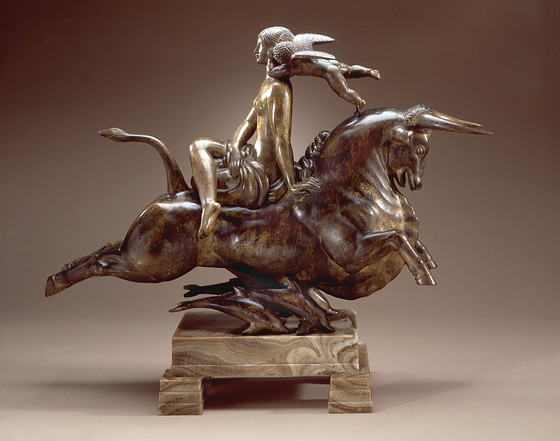Flight of Europa is a stunning art deco sculpture modeled by Paul Manship (1885-1966) in 1925, the year the landmark Paris Exposition Internationale des Arts Décoratifs et Industriels Modernes introdu...
Flight of Europa is a stunning art deco sculpture modeled by Paul Manship (1885-1966) in 1925, the year the landmark Paris Exposition Internationale des Arts Décoratifs et Industriels Modernes introduced this new aesthetic. Only a decade before, Manship had finished studying at the American Academy in Rome, which concentrated on classicism. The young artist, however, quickly transformed the old tradition into a vital language expressive of a new age and consequently became America’s premier modern sculptor.
According to classical mythology, Zeus, the king of the gods, fell in love with the beautiful Phoenician princess Europa and assumed the guise of a bull the seduce her. Initially frightened, Europa eventually climbed onto the bull’s back and was carried over the sea to the island of Crete, where the two made love. Europa bore Zeus three sons, one of who was Minos, the future king of Crete.
Manship, visiting the Boston palazzo of art collector Isabella Stewart Gardner, was inspired by her Titian painting of Europa and created the first of three works devoted to the theme. Flight would be the last and most elaborate of the Europa sculptures. Despite the antiquity of the Europa story, Manship rejected any sense of classical serenity in his design, preferring to convey the speed of the modern era. The overall composition of the bronze, with its open base and emphasis on diagonal lines, contributes to a sense of buoyancy. Even though the bull is massive, it appears to leap effortlessly through the air.
The dolphins beneath the bull symbolize the Mediterranean Sea and the flight to Crete. Manship’s interpretation surely was stimulated by frescoes depicting dolphins and men leaping over bulls that he saw during his visit to the excavation of the ancient Minoan palace of Knossos in 1924. Manship had long been intrigued by figures in motion and by the early 1920s was already presenting them seemingly airborne.
The sculpture’s delicately gilded surface and original beige-and-white onyx base not only demonstrate Manship’s love of expensive materials and rich surfaces: above all, they illustrate his exquisite sense of taste. Nothing was overdone. The decorative linear detailing, which became Manship’s hallmark, is limited to small areas: Europa’s coiffure, Cupid’s wings and hair, and the bull’s mane. Even his approach to the story is one of decorum: Europa sits upright, her legs crossed in a ladylike manner, calmly listening to the words of love being whispered into her ear. No hint of violence or abandon that would suggest a rape is included.
Only five casts of Flight of Europa have been located, and this is the last one to enter a public collection. This piece was so cherished by Manship’s devoted supporters Edwin and Sarah Holter that it remained with their descendants for more than 70 years. Through the generosity of the American Art Council, its members, and the Shirley Filiatrault Trust, the museum has been able to add this major sculpture to its collection.
More...
